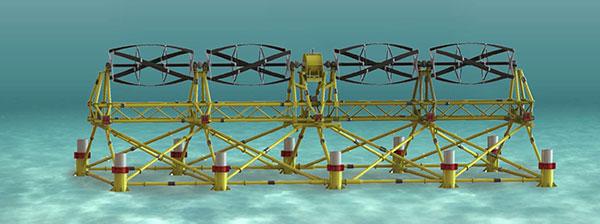
Ocean Renewable Power Company (ORPC) Tidal Turbine
Our recent posts about tidal turbines to create clean energy have raised interesting comments and questions about the impact of the underwater turbines on fish and mammals. Will seals, seabirds, and fish be sliced and diced by underwater turbines? Will the sounds of underwater generators disrupt the marine habitat? Are these new technologies doing more harm than good?
While there is always more research to be done, all indications are that the tidal turbines, in their various forms, are not harming sealife. Indeed, in one case, the turbine installation may have created a marine sanctuary of sorts, promoting marine life.
One group monitoring the impact of marine renewable energy (MRE) on sealife is Tethys. Tethys, named after the Greek titaness of the sea, was developed in 2009 by the Pacific Northwest National Laboratory (PNNL) to support the U.S. Department of Energy (DOE) Wind Energy Technologies Office and Water Power Technologies Office.
From their website: In order to address the growing global demand for energy, industry is looking to extract energy from renewable sources such as wind, waves, and tides. Yet potential environmental effects must be evaluated and measured to ensure that animals, habitats, and ecosystem functions are not adversely affected, nor that existing ocean and land uses be displaced. The goal of Tethys is to progress industry in an environmentally-responsible manner.
So what has Tethys concluded? Are fish being struck by underwater turbines? Apparently not.
From Are fish in danger? A review of environmental effects of marine renewable energy on fishes: Field- and laboratory-based studies that have examined fish presence, avoidance, and evasion around MRE devices suggest that collisions are rare.
And what about noise and magnetic fields from power cables? Studies exposing fish to turbine-generated noise and electromagnetic fields demonstrate little effect on fish behavior; in fact, MRE device noise falls below reported hearing thresholds.
Are seals threatened by underwater turbines? Apparently, seals are smart enough to avoid the turbines. From Quantifying the effects of tidal turbine array operations on the distribution of marine mammals: Implications for collision risk: Seals showed overt avoidance responses during turbine operations, with a significant decrease in predicted abundance (95% CIs: −11%, −49%) within ∼2 km of the array.
Overall researchers have found that compared to other coastal energy projects, such as offshore oil drilling, the threat of most planned wave and tidal energy setups is quite low.

Drop a lobster trap on one side and tell me what happens when the turbine gets snarled with the buoy rope. As well as how many ropes can it handle until it stops working.
Or what will happen when a muscle dragger gets fouled in a turbine? Will it sink the boat? Or will the boat become part of a circuit and rip up the cables?
Will there be fan guards on the rotating blades because the urchin divers didnt pay attention and found the turbine platform the ideal spot to catch urchins?
These are the usual concerns that fishermen will raise and get any tidal turbine projects axed while still in the planning stage.
Currently in Frenchman’s Bay is a desire to create a fish factory. The group wants to set up a series of pens to grow fish. Blue signs now dot the small towns around Frenchman’s Bay declaring “Say NO to the factory”. As some one is stirring up the locals with a smog generationg smoke stack and visions of past trawlers that destroyed the ecoology in the past.
Seals may have the common sense to avoid the turbines but back in 2013 a sailing vessel managed to hit one in Strangford Lough in Ireland. Fortunately the three crew were rescued by other vessels after being thrown into the water. The vessel was not holed but was dismasted.
I am guessing it was a sailing dinghy and it may be that it was carried on to the superstructure of the turbine by the tide rather than being struck by one of the blades.
The article I read was a bit short on facts.
Willy, in regards to your post, isn’t it the logical answer that these sites would already be marked out via oceanographic surveys, inclusion on the respective charts and ENCs, etc.?
It would seem to me that this is the logical dissemination method (along with USCG local notices to mariners), unless I am missing something? (Asks the guy that provided IT support to Coast Survey for a bit)